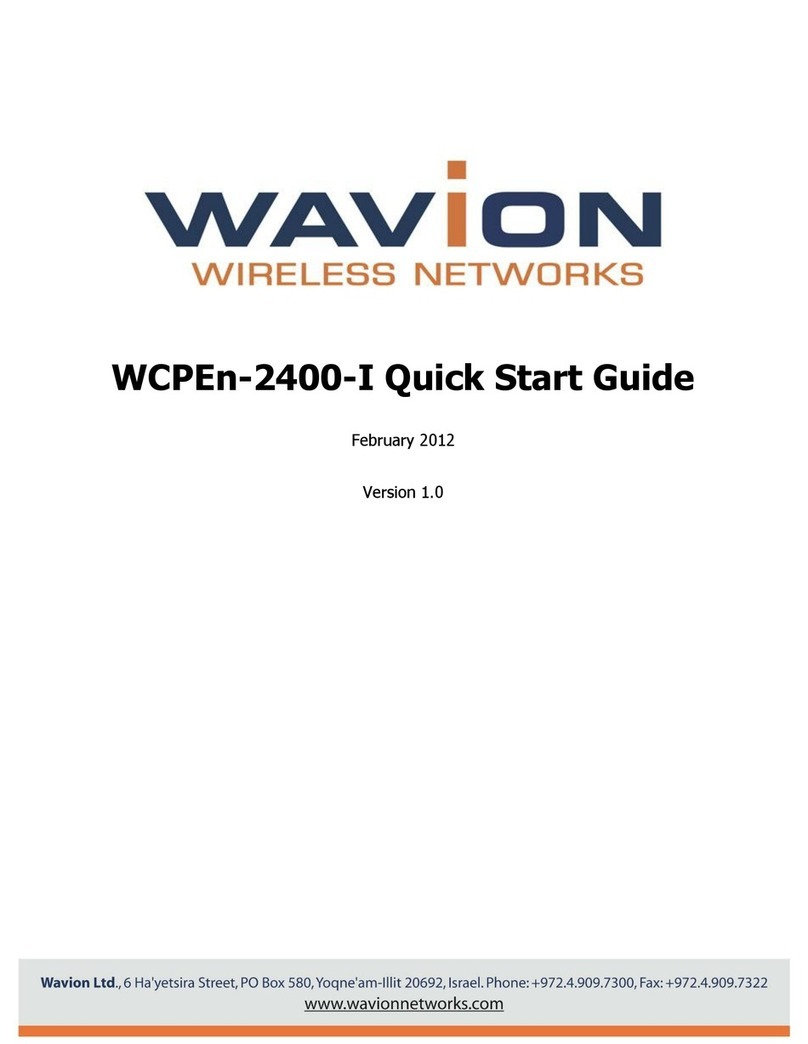
WBSn-2450 User Guide Page - 5 -
1. Introduction
WBSn-2450 base stations combine Wavion’s true two-way 802.11n Beamforming and interference
immunity technologies together with 3x3:3 MIMO, and deliver best capacity and coverage in all
environments. The spatially adaptive Beamforming signals travel in different propagation paths, and are
coherently combined at the receiver’s antenna. The Beamforming is combined with a unique High Gain
Diversity Polarized (HGDP) antenna array for maximum performance, and increases coverage by up to
50%, enabling NLOS connectivity, indoor signal penetration, and significant interference suppression.
The WBSn-2450 concurrently supports 2.4 and 5 GHz delivering aggregated capacity of 900Mbps. The 5
GHz is configurable for backhaul or access.
Utilizing a decade of outdoor Wi-Fi experience, Wavion’s Interference Immunity Suite includes:
•Beamforming, with its inherent ability to suppress interference
•The Dynamic Interference Handling (DIH) algorithm, that continuously optimizes receiver’s
parameters according to varying noise levels
•The Automatic Channel Selection (ACS) algorithm, that automatically online identifies, selects
and utilizes the best operating channel selection
•The Wavion Rate Adaptation (WARA) which enables optimal rate selection in outdoor
environments with high interference
•Down Tilted Antenna (DTA) and sector antenna abilities to reject noise out of their fields-of-view
WBSn base stations are carrier grade, ruggedized IP-68 rated units, designed to provide the highest
reliability, quality of service, security and manageability. WBSn base stations come with a complete set of
FCAPS management tools.
WBSn base stations comprising rich embedded networking capabilities, including Routing and a fully
integrated Access Controller, for flexible service planning and reduced costs.
WBSn is designed to be environmentally-friendly with low power consumption, fewer sites to power,
aesthetic smart design, and green standard compliance.
With fewer sites required per covered area, highest network reliability and enhanced service options,
WBSn provides up to 50% savings of CAPEX and OPEX and the fastest ROI.
WBSn-2450 Key Benefits:
•Exceptional coverage and NLOS performances
•Best indoor signal penetration
•Concurrent support for 2.4 and 5 GHz
•Up to 900Mbps capacity
•Unique interference immunity suite
•Full compatibility with standard
802.11 a/b/g/n clients
•Small form factor and easy to deploy
•Low power consumption
•Robust outdoor design, IP-68 rated
•Simple deployment and low infrastructure and
operating costs
Important Note:
Wavion base stations are comprised of highly advanced technical equipment. Only experienced
installation professionals who are familiar with local building and safety codes, and other relevant
regulations, and wherever applicable are licensed by the appropriate government regulatory authorities,





























